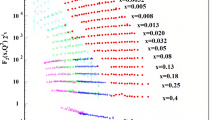Abstract
Nucleon form factors at large momentum transfer are important for understanding the transition from nonperturbative to perturbative QCD and have been the focus of experiment and phenomenology. We calculate proton and neutron electromagnetic form factors \(G_{E,M}(Q^2)\) from first principles using nonperturbative methods of lattice QCD. We have accumulated large Monte Carlo statistics to study form factors up to momentum transfer \(Q^2\lesssim 8\text { GeV}^2\) with a range of lattice spacings as well as quark masses that approach the physical point. In this paper, results of initial analyses are presented and compared to experiment, and potential sources of systematic uncertainty are discussed.








Similar content being viewed by others
References
V. Punjabi, C.F. Perdrisat, M.K. Jones, E.J. Brash, C.E. Carlson, The structure of the nucleon: elastic electromagnetic form factors. Eur. Phys. J. A 51, 79 (2015). https://doi.org/10.1140/epja/i2015-15079-x. arXiv:1503.01452 [nucl-ex]
Z.-F. Cui, C. Chen, D. Binosi, F. Soto, C.D. Roberts, J. Rodríguez-Quintero, S.M. Schmidt, J. Segovia, Nucleon elastic form factors at accessible large spacelike momenta. Phys. Rev. D 102(1), 014043 (2020). https://doi.org/10.1103/PhysRevD.102.014043. arXiv:2003.11655 [hep-ph]
J. Arrington, E. Christy, S. Gilad, B. Moffit, V. Sulkosky, B. Wojtsekhowski, et al.: Precision Measurement of the Proton Elastic Cross Section at High \(Q^2\). Jefferson Lab Experiment 12-07-108, https://www.jlab.org/exp_prog/proposals/07/PR12-07-108.pdf (2007)
E. Brash, E. Cisbani, M. Jones, M. Khandaker, N. Liyanage, L. Pentchev, C.F. Perdrisat, V. Punjabi, B. Wojtsekhowski, Large Acceptance Proton Form Factor Ratio Measurements at 13 and 15 \((\rm GeV/c)^2\) Using Recoil Polarization Method. Jefferson Lab Experiment 12-07-109, https://www.jlab.org/exp_prog/proposals/07/PR12-07-109.pdf (2008)
G. Cates, S. Riordan, B. Wojtsekhowski, et al., Measurement of the Neutron Electromagnetic Form Factor Ratio\(G_{En}/G_{Mn}\)at High\(Q^2\)
J. Annand, R. Gilman, B. Quinn, B. Wojtsekhowski, et al., Precision measurement of the Neutron Magnetic Form Factor up to\(Q^2=18.0 ({{\rm GeV}}/c)^2\)by the Ratio Method. Jefferson Lab Experiment 12-09-019, https://www.jlab.org/exp_prog/proposals/09/PR12-09-019.pdf (2009)
W. Brooks, J. Lachniet, M. Vineyard, et al., Measurement of the Neutron Magnetic Form Factor at High\(Q^2\)Using the Ratio Method on Deuterium. Jefferson Lab Experiment 12-07-104, https://www.jlab.org/exp_prog/proposals/07/PR12-07-104.pdf (2007)
M.E. Christy et al., Form factors and two-photon exchange in high-energy elastic electron-proton scattering. Phys. Rev. Lett. 128(10), 102002 (2022). https://doi.org/10.1103/PhysRevLett.128.102002. arXiv:2103.01842 [nucl-ex]
A.J. Chambers et al., Electromagnetic form factors at large momenta from lattice QCD. Phys. Rev. D 96(11), 114509 (2017). https://doi.org/10.1103/PhysRevD.96.114509. arXiv:1702.01513 [hep-lat]
G.P. Lepage, The Analysis of Algorithms for Lattice Field Theory. Invited lectures given at TASI’89 Summer School, Boulder, CO, 4–30 June 1989
S. Syritsyn, A.S. Gambhir, B. Musch, K. Orginos, Constructing Nucleon Operators on a Lattice for Form Factors with High Momentum Transfer. PoS LATTICE2016, 176 (2017)
C. Kallidonis, S. Syritsyn, M. Engelhardt, J. Green, S. Meinel, J. Negele, A. Pochinsky, Nucleon electromagnetic form factors at high \(Q^2\) from Wilson-clover fermions. in 36th International Symposium on Lattice Field Theory (Lattice 2018) East Lansing, MI, United States, 22-28 July 2018 (2018)
G.S. Bali, B. Lang, B.U. Musch, A. Schäfer, Novel quark smearing for hadrons with high momenta in lattice QCD. Phys. Rev. D 93(9), 094515 (2016). https://doi.org/10.1103/PhysRevD.93.094515. arXiv:1602.05525 [hep-lat]
S.N. Syritsyn, J.D. Bratt, M.F. Lin, H.B. Meyer, J.W. Negele et al., Nucleon electromagnetic form factors from lattice QCD using 2+1 flavor domain wall fermions on fine lattices and chiral perturbation theory. Phys. Rev. D 81, 034507 (2010). https://doi.org/10.1103/PhysRevD.81.034507. arXiv:0907.4194 [hep-lat]
J. Green, S. Meinel, M. Engelhardt, S. Krieg, J. Laeuchli, J. Negele, K. Orginos, A. Pochinsky, S. Syritsyn, High-precision calculation of the strange nucleon electromagnetic form factors. Phys. Rev. D 92, 031501 (2015). https://doi.org/10.1103/PhysRevD.92.031501. arXiv:1505.01803 [hep-lat].[Phys.Rev.D92,031501(2015)]
W.M. Alberico, S.M. Bilenky, C. Giunti, K.M. Graczyk, Electromagnetic form factors of the nucleon: new Fit and analysis of uncertainties. Phys. Rev. C 79, 065204 (2009). https://doi.org/10.1103/PhysRevC.79.065204. arXiv:0812.3539 [hep-ph]
A.V. Belitsky, X.-D. Ji, F. Yuan, A perturbative QCD analysis of the nucleon’s Pauli form-factor \(F_2(Q^2)\). Phys. Rev. Lett. 91, 092003 (2003). https://doi.org/10.1103/PhysRevLett.91.092003. arXiv:hep-ph/0212351 [hep-ph]
G.D. Cates, C.W. Jager, S. Riordan, B. Wojtsekhowski, Flavor decomposition of the elastic nucleon electromagnetic form factors. Phys. Rev. Lett. 106, 252003 (2011). https://doi.org/10.1103/PhysRevLett.106.252003. arXiv:1103.1808 [nucl-ex]
A. Pochinsky, Qlua Lattice Software Suite. https://usqcd.lns.mit.edu/qlua (2008–present)
Acknowledgements
S.S. is supported by the National Science Foundation under CAREER Award PHY-1847893. Any opinions, findings, and conclusions or recommendations expressed in this material are those of the author(s) and do not necessarily reflect the views of the National Science Foundation. S.M. is supported by the U.S. DOE, Office of Science, Office of High Energy Physics under Award Number DE-SC0009913. M.E., J.N. and A.P. are supported by the U.S. DOE, Office of Science, Office of Nuclear Physics through grants numbered DE-FG02-96ER40965, DE-SC-0011090 and DE-SC-0023116, respectively. The research reported in this work made use of computing and long-term storage facilities of the USQCD Collaboration, which are funded by the Office of Science of the U.S. Department of Energy. The authors gratefully acknowledge the Gauss Centre for Supercomputing e.V. (www.gauss-centre.eu) for funding this project by providing computing time through the John von Neumann Institute for Computing (NIC) on the GCS Supercomputer JUWELS at Jülich Supercomputing Centre (JSC). This research also used resources of the National Energy Research Scientific Computing Center, a DOE Office of Science User Facility supported by the Office of Science of the U.S. Department of Energy under Contract No. DE-AC02-05CH11231 using NERSC award NP-ERCAP0024043. The computations were performed using the Qlua software suite [19].
Author information
Authors and Affiliations
Contributions
Main text and figures prepared by S.S. All authors reviewed the manuscript.
Corresponding author
Ethics declarations
Conflict of interest
The authors declare no competing interests.
Additional information
Publisher's Note
Springer Nature remains neutral with regard to jurisdictional claims in published maps and institutional affiliations.
Rights and permissions
Springer Nature or its licensor (e.g. a society or other partner) holds exclusive rights to this article under a publishing agreement with the author(s) or other rightsholder(s); author self-archiving of the accepted manuscript version of this article is solely governed by the terms of such publishing agreement and applicable law.
About this article
Cite this article
Syritsyn, S., Engelhardt, M., Green, J. et al. Nucleon Electromagnetic Form Factors at Large Momentum Transfer from Lattice QCD. Few-Body Syst 64, 72 (2023). https://doi.org/10.1007/s00601-023-01839-4
Received:
Accepted:
Published:
DOI: https://doi.org/10.1007/s00601-023-01839-4



